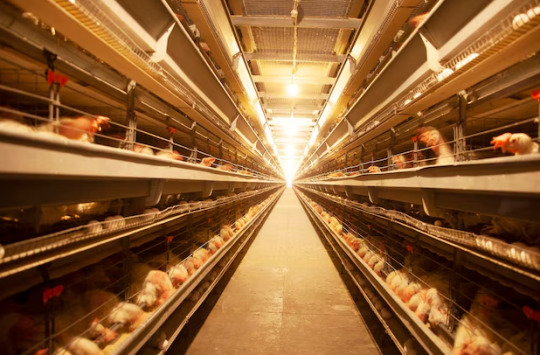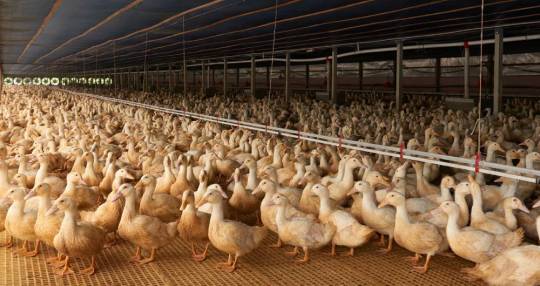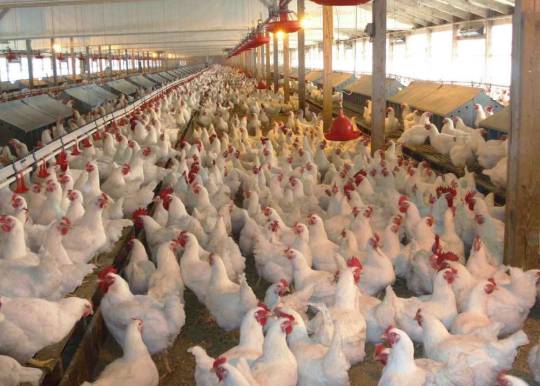Don't wanna be here? Send us removal request.
Text
Blue Light in Poultry Farming: Science-Backed Benefits
Blue Light in Poultry Farming: Science-Backed Benefits

Blue light (400–500 nm) is gaining attention in poultry farming for its unique biological impacts on birds. Here’s how tailored blue-spectrum systems optimize flock performance:
1. Biological Effects Blue light influences avian circadian rhythms and melatonin regulation, promoting calmness and reducing stress. Studies show it suppresses aggressive behaviors like feather pecking by up to 30% in laying hens.
2. Growth & Feed Efficiency Broilers exposed to blue light exhibit improved feed conversion ratios (FCR) due to enhanced appetite regulation. The cool spectrum encourages steady feeding activity without overstimulation, supporting uniform growth.
3. Layer Productivity While red light remains key for egg production, blue light supplementation during rest phases stabilizes reproductive cycles. It also reduces cortisol levels, improving eggshell quality and hen longevity.
4. Practical Applications
Use low-intensity blue light (5–10 lux) for broilers during nighttime feeding phases.
Combine blue with green wavelengths (500–570 nm) to amplify calming effects.
Install programmable LED systems to cycle blue light during specific growth stages.
5. Caveats
Avoid prolonged exposure, as excessive blue light may disrupt sleep patterns.
Ensure uniform distribution to prevent shadow-induced stress.
Pair with warmer spectra (e.g., red) during daytime to balance behavioral needs.
refer:blue light poultry
0 notes
Text
Poultry Lights: Essential Insights for Optimal Flock Performance
Poultry Lights: Essential Insights for Optimal Flock Performance

Poultry lighting plays a pivotal role in modern farming, directly impacting bird health, growth, and productivity. Here’s what every poultry farmer should know:
1. Purpose-Driven Design Poultry lights are tailored to replicate natural light patterns, regulating chickens’ circadian rhythms. Proper illumination supports vital behaviors like feeding, mating, and rest, ensuring balanced development.
2. Types of Poultry Lights
LEDs: Energy-efficient, durable, and customizable in spectrum and intensity. Ideal for long-term savings.
Fluorescent: Budget-friendly but less efficient and prone to flickering.
Incandescent: Outdated, energy-intensive, and short-lived—now largely replaced by LEDs.
3. Key Benefits
Enhanced Egg Production: 14–16 hours of daily light for layers maximizes laying rates.
Improved Growth: Broilers thrive under dimmable, low-stress lighting that encourages steady feeding.
Behavioral Control: Red-spectrum lights reduce pecking and aggression.
4. Smart Features Modern systems integrate timers, dimmers, and automation to maintain consistent cycles. Motion sensors and remote controls add convenience, while data-driven adjustments align lighting with flock age and needs.
5. Cost & Maintenance LEDs offer the lowest lifetime costs despite higher upfront prices. Regular cleaning and avoiding moisture exposure extend fixture lifespan.
0 notes
Text
Poultry Lighting Systems: Innovations for Healthier Flocks
Poultry Lighting Systems: Innovations for Healthier Flocks

Modern poultry lighting systems are engineered to optimize bird welfare, productivity, and farm efficiency. Here’s a breakdown of their key features and benefits:
1. Core Components
LED Fixtures: Energy-efficient, long-lasting bulbs with adjustable intensity and spectrum.
Dimmers & Timers: Enable precise control over light duration and brightness, mimicking natural day-night cycles.
Programmable Controllers: Automate lighting schedules to reduce human error.
2. Spectrum Customization
Red Light (600–700 nm): Enhances egg production in layers and reduces aggressive behavior.
Blue-Green Light (400–570 nm): Promotes calmness and optimal growth in broilers.
Warm White (2700K–3000K): Ideal for chicks to encourage feeding and activity.
3. Smart Technology Integration
Motion Sensors: Adjust light intensity based on bird movement.
Data Analytics: Track flock performance metrics linked to lighting patterns.
Remote Monitoring: Manage systems via mobile apps for real-time adjustments.
4. Energy & Cost Efficiency LED systems slash energy use by 60–80% compared to incandescent bulbs. Their durability minimizes replacement costs and labor.
5. Welfare-Focused Design
Low-heat emission prevents coop overheating.
Gradual sunrise/sunset simulations reduce stress and support circadian rhythms.
Best Practices
Clean fixtures monthly to maintain light quality.
Align light schedules with bird age and breed requirements.
Integrate lighting with ventilation systems for holistic climate control.
0 notes
Text
Lighting Management in Poultry: Strategies for Success
Lighting Management in Poultry: Strategies for Success
Effective lighting management is a cornerstone of modern poultry farming, influencing growth, reproduction, and overall flock health. Here’s how to optimize light systems for maximum productivity:
1. Light Duration & Schedule
Layers: Provide 14–16 hours of light daily to stimulate egg production. Sudden changes can disrupt laying cycles.
Broilers: Gradually reduce light exposure (e.g., 20 lux to 5 lux) to minimize stress and support muscle development.
2. Spectrum Selection
Red light (600–700 nm) boosts egg production and reduces aggression.
Blue-green light (400–570 nm) enhances calmness and feed efficiency. Avoid overly bright white LEDs, which may disturb natural behaviors.
3. Intensity Control Use dimmers to mimic dawn/dusk transitions, easing birds into light/dark phases. Adjust intensity based on age:
Chicks: 20–30 lux for activity.
Adults: 5–10 lux for restful periods.
4. Energy Efficiency LED bulbs cut energy costs by 80% and last 5x longer than traditional bulbs. Their low heat output also prevents coop overheating.
5. Monitoring & Automation Install timers and sensors to maintain consistent cycles. Regularly clean fixtures to ensure uniform light distribution.
0 notes
Text
LED Chicken Lighting: Key Benefits for Modern Poultry Farms
LED Chicken Lighting: Key Benefits for Modern Poultry Farms
Switching to LED lighting in poultry houses offers significant advantages for both bird health and farm efficiency. Here’s why more farmers are adopting this technology:
1. Energy Savings & Cost Reduction LED bulbs consume up to 80% less energy than traditional incandescent or fluorescent lights. Their long lifespan (50,000+ hours) reduces replacement costs and labor.
2. Enhanced Productivity
Laying Hens: 14–16 hours of optimized LED light daily increases egg production by up to 20%.
Broilers: Adjustable intensity supports steady growth and reduces stress, improving feed conversion ratios.
3. Customizable Light Spectrum
Red Light (600–700 nm): Boosts egg-laying and minimizes aggression.
Blue-Green Light (400–570 nm): Encourages calm behavior and better weight gain.
4. Animal Welfare LEDs emit minimal heat, preventing overheating in coops. Dimmable systems mimic natural dawn/dusk transitions, aligning with chickens’ circadian rhythms.
5. Environmental Control Waterproof and durable designs withstand harsh farm conditions. Smart timers ensure consistent light cycles, crucial for flock health.
refer:led chicken lighting benefit
0 notes
Text
Poultry Light Bulbs: Optimizing Health and Productivity
Poultry Light Bulbs: Optimizing Health and Productivity
Lighting plays a crucial role in poultry farming, directly impacting bird behavior, growth, and egg production. Modern poultry light bulbs are designed to mimic natural daylight cycles, ensuring optimal physiological responses in chickens.
Key Considerations:
Spectrum & Intensity
Red Light (600–700 nm): Enhances egg production and reduces aggression.
Blue-Green Light (400–570 nm): Promotes calmness and improves feed conversion.
Avoid harsh white LEDs, which may disrupt circadian rhythms.
Energy Efficiency LED bulbs are preferred for their longevity, low heat emission, and adjustable brightness. They consume 80% less energy than incandescent bulbs.
Lighting Schedule
Layers: 14–16 hours of light daily to stimulate laying.
Broilers: Gradual dimming to prevent stress and support muscle development.
Best Practices
Use dimmers to simulate dawn/dusk transitions.
Install timers for consistent light cycles.
Regularly clean bulbs to maintain intensity.
1 note
·
View note